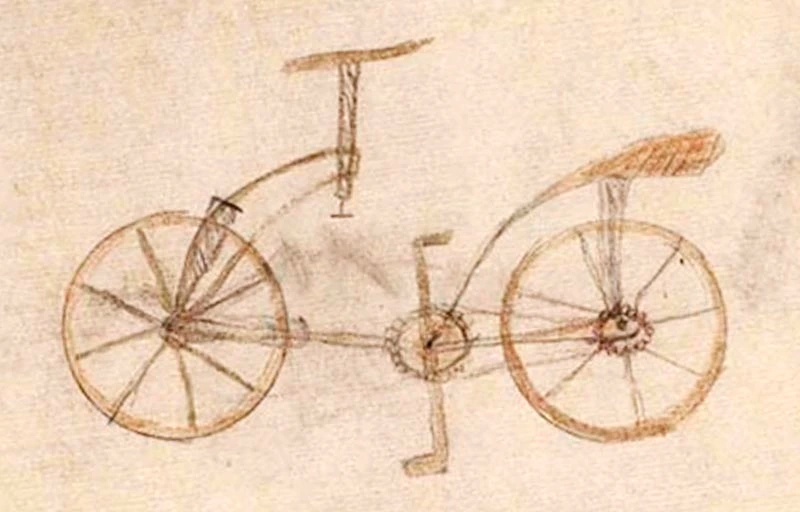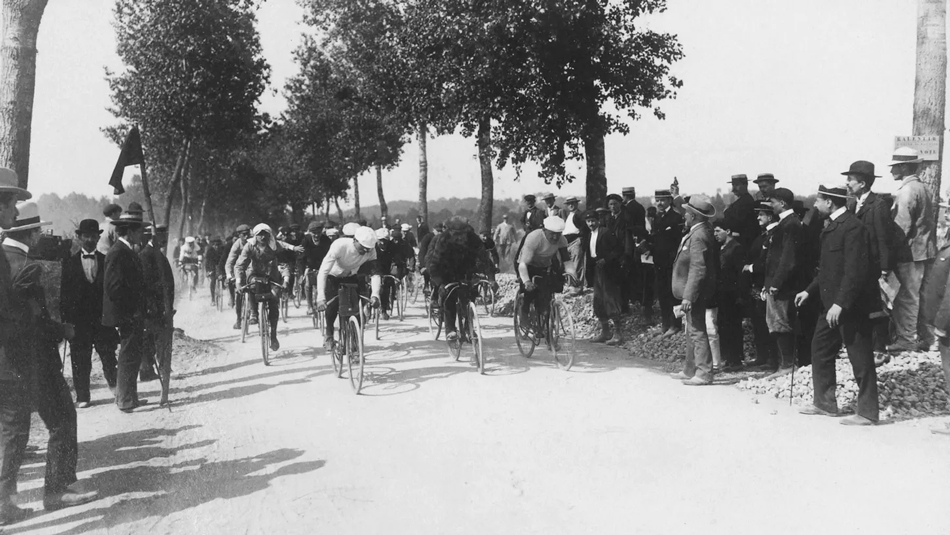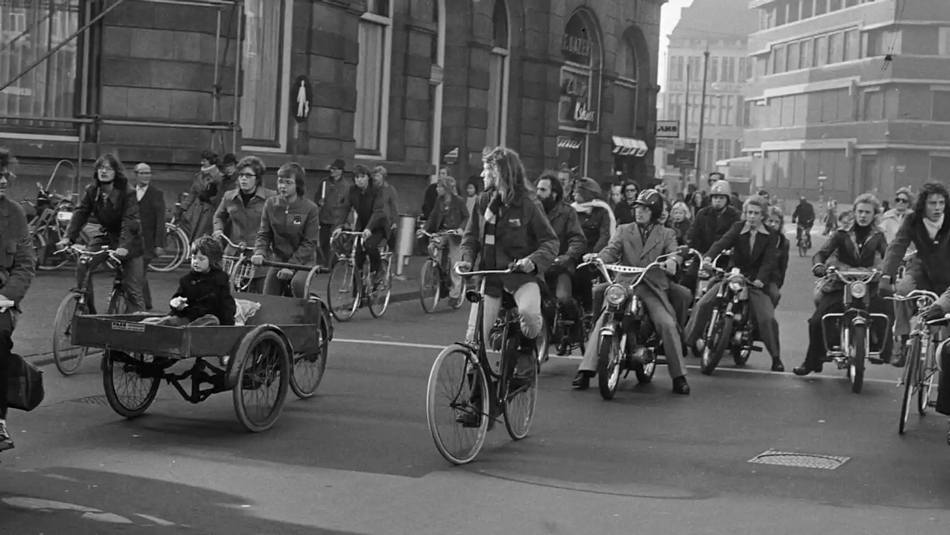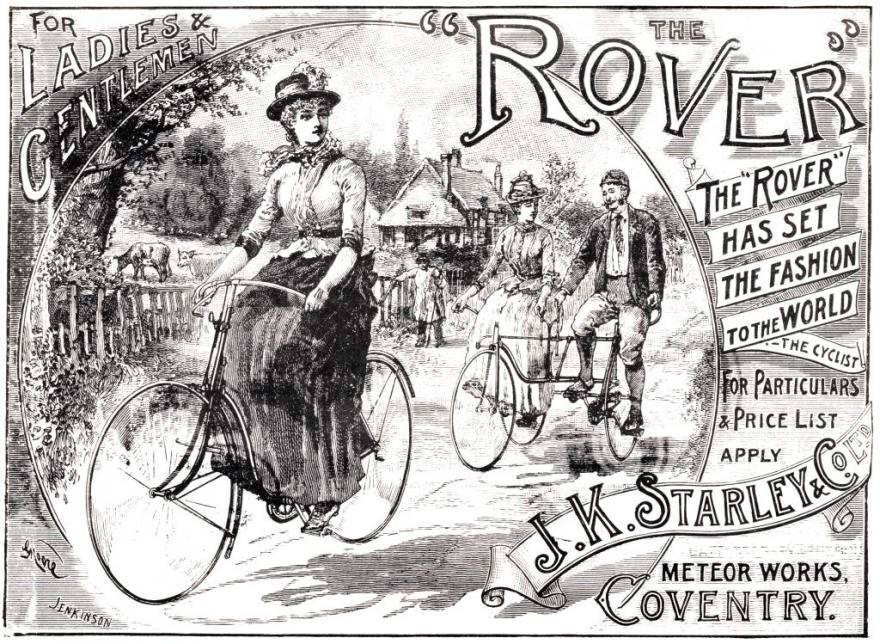Defined as the perfect machine or the machine of happiness, it is more than 200 years old. The history of the bicycle and its evolution is an exciting chronicle.
Origins of the Modern Bicycle
From the first devices propelled with one's own feet on the ground, to the modern bicycle with high technology, there is a long road of ingenuity, innovation and evolution.
For many years, the starting point of the invention of the bicycle in the 15th century, with a rudimentary sketch attributed to Leonardo da Vinci in the Codex Atlanticus, but this is a hoax already dismantled in recent studies that have proven that the drawing is a later manipulation, most likely from the 20th century. Although the great Renaissance genius had the necessary knowledge for it, he never designed anything resembling a bicycle.
 Drawing of a bicycle falsely attributed to Leonardo da Vinci
Drawing of a bicycle falsely attributed to Leonardo da VinciIt was throughout the nineteenth century when the bicycle was invented on which have been developed the multiple models of bicycles that exist today. We will take a look at the origin of the bicycle, the most significant inventors in the evolution of the bicycle, the current state of this great invention and an outline of its future.
The most repeated questions in internet searches related to the history of bicycles are Who was the inventor of the bicycle? In what year was the bicycle invented? Where was the bicycle invented? Or How was the bicycle created?
In 1645, the Frenchman Jean Théson made and rode a two-wheeled device that he propelled with his feet and baptized as a celerator. Although it had the basic elements of the bicycle, which are the structure and the two wheels, it did not have a steering system to guide it, so it is not yet considered a bicycle. Also in France, other similar devices were built and, in 1799, M. Blanchard and M. Masurier built and christened the velocycle, which we can consider as a precursor of the bicycle.
Who invented the bicycle and when?
The first bicycle in history that can be considered as such, although it had no pedals, was designed and built by the German Karl Christian Ludwig Drais von Sauerbronn. It was he who created the bicycle, and the year 1817 when the bicycle was created.
And the name of the first bicycle is draisiana, which is how the device was named in honor of its creator. It allowed movement on two wheels by propelling itself with the feet, but it already had a rudimentary steering system and was the precursor for the design of later bicycles with pedals.
And the first bicycle was the draisiana, named after its creator.
 Draisian Bicycle 1818
Draisian Bicycle 1818Evolution of the Bicycle
The spark was lit and from there continued its evolution.
In 1839, the Scottish blacksmith Kirkpatrick Macmillan developed a more manageable steering system than the German prototype and incorporated pedals to the bicycle, although they were very different from the current ones, as platforms, and he failed to popularize his invention.
It was in the 1860s that the bicycle began to take its current form. The Frenchman Pierre Michaux along with his son, Ernest Michaux, created the first bicycle with pedals in 1861, which they put on the front wheel, along with an effective steering system. Their bicycle, called Michauline, went into mass production and achieved great popularity. However, it still had iron wheels and was extremely uncomfortable to ride. Gradually, modifications were produced that made the bikes more comfortable, including rubber tires. Numerous models of tricycles or quadricycles were also launched, as inventors sought means of transport that could be adapted to all needs. The demand for and introduction of bicycles was growing, and important advances continued to be made.
 Michaulin bicycle
Michaulin bicycleIn 1864, James Slater produced the first bicycle with a chain drive. And the Englishman James Starley, in 1870, introduced wire spokes and the bicycle with a smaller rear wheel and a much larger front wheel, known as the penny-farthing. This design achieved great popularity, especially in Victorian society in England, but for a short period of time. It allowed greater speed compared to earlier bicycles, but was unstable in the face of obstacles and difficult to steer. James Starley also designed and built the first bicycle for women, which had only one pedal and was maneuvered sideways to avoid ladies having to show their legs, frowned upon in the society of the time.
 Penny-farthing bicycle in London, 1932 (Photo by Fox Photos/Getty Images)
Penny-farthing bicycle in London, 1932 (Photo by Fox Photos/Getty Images)The Modern Bicycle
The British engineer John Kemp Starley revolutionized the bicycle and invented the modern bicycle at the end of the 19th century. He, who was James Starley's nephew, introduced the Rover Safety Bicycle in 1885, which incorporated a lightweight, rhomboidal frame, two wheels of the same size, chain and gear transmission, pedals, crank and direct drive with inclined fork. The "safety bike" was fast, comfortable and easy to ride.
The safety bike
Another prominent name in the history of the bicycle was the Scotsman John Boyd Dunlop, who in 1888 patented the air tire for bicycles. This revolutionary invention greatly improved the comfort and performance of bicycles, providing effective cushioning and increased traction on different surfaces. Subsequently, the Michelin brothers patented the radial tire, which is still used by automobiles.
The Golden Age of the Bicycle
While in the early days of their mass introduction they faced problems due to conflicts with pedestrians and horse-drawn carriages, in Europe, the expansion of the rail network and the development of roads contributed to the increased demand for bicycles. Improvements in design, such as the introduction of pedals and chain drives, along with advances in manufacturing and marketing, made bicycles more accessible and affordable to a growing number of people. They were the king of city vehicles. And the late 19th and early 20th centuries saw the Golden Age of bicycles, mostly in Europe and America, although it also penetrated Asia and especially China. During this period, bicycles experienced a boom in popularity and became a widely used means of transportation, as well as a form of leisure and sport.
Bicycles also became a symbol of freedom and mobility, especially for women, as they provided them with an independent form of transportation. It also came to be called the “freedom machine”. And, in its sporting facet, bicycle racing and bicycle touring became popular, and cycling clubs and associations sprang up all over Europe.
 1st Tour de France in 1903 - The Picture Art Collection, Alamy
1st Tour de France in 1903 - The Picture Art Collection, AlamyThe Golden Age of bicycles was eclipsed with the advent of the automobile in the early 20th century, which quickly became the preferred mode of transportation for many. Although bicycles remained popular and advances in their design and technology continued, their dominance as a mode of transportation gradually diminished.
However, bicycles have experienced a major resurgence in recent decades, which has been a real boom since 1960, due to three main reasons:
-
The energy crisis of the 1970s.
-
The need and interest in seeking sustainable mobility in cities, in which the bicycle is emerging as the cleanest, healthiest and most sustainable means of transportation.
-
The resurgence of cycling as a sport and recreational activity, in a society with more leisure and travel opportunities.
All over the world, and especially in Europe, an extensive cycling infrastructure is growing rapidly and cities are promoting cycling.
 Bicycles in Amsterdan the 1970s
Bicycles in Amsterdan the 1970sTypes of Bicycles
In their evolution, manufacturers have developed various types of bicycles. Initially, there were multi-purpose city bikes, all-purpose bikes, touring bikes, road bikes and cyclocross bikes. Later, folding bikes were developed.
Two important milestones in the bicycle boom were the birth of the BMX bikes, in the early 1970s, and the mountain bikes in the middle of that decade.
Nowadays, all the disciplines have evolved separately, with multiple profiles of very specialized bikes. In the road, for example, there are the racing or climbing bikes, the Grand Fondo and the aeros. And new disciplines such as gravel are also emerging, which are also splitting into the more sport oriented and the more adventurous and comfortable ones.
But the greatest journey is found in the short history of mountain biking, which has been divided into XC, Down Country, Trail, Enduro and Downhill bikes.
And, the last great revolution affecting all types of bikes and disciplines has been with electric bikes. They have created another way of looking at cycling, facilitating access to the sport for many more people, and have become a perfect option for transportation in the sustainable cities of the future. Despite the short history of the electric bicycle, we already find electric-assist bicycles of all disciplines, and the incorporation of electric assistance has been the most important milestone in cycling in the last decade.
Another important milestone for the future of bicycles is the increasing incorporation of electronics, which are already beginning to intelligently manage transmissions, suspensions, brakes and even riding techniques, such as the ABS brakes already incorporated in some models, or accident detection and warning. Undoubtedly, cycling is more alive than ever, and expectations are high.
As for the history of the bicycle in Spain, it has also had its own chapter, because, although the national brands were not pioneers in its birth, there are several that have reached a great international level, with products of own and differentiated development, as the well known Orbea and BH, or the more modern Mondraker and MMR, among others.
 Specialized Turbo Kenevo electric
Specialized Turbo Kenevo electricFinal Conclusions
With this brief summary of the history of the bicycle, we have condensed centuries of the evolution of this wonderful machine, which continues to excite generation after generation, with the incomparable pleasure that comes from riding a bike.
From its origins centuries ago, until the modern bicycle and the innovative electric bicycles, it has had ups and downs as a means of transportation, but it has ended up establishing itself as a sustainable and healthy alternative for travel, especially in short journeys in cities, where it has no competition in any of the important aspects:
-
Energy and resource consumption, both in their manufacture and operation
-
Environmental friendliness, especially in cities
-
The great health benefits of its use for the general population
The bicycle continues to be a symbol of freedom, adventure and mobility, and its history will continue with new technologies as a great ally for its promotion.
Bicycles and cycling are the raison d'être of our company and the people who are a part of it. Therefore, in the Mammoth stores and in Mammoth online, you will find the largest assortment of all types of bicycles and accessories related to cycling and a lot of passion for this sport.


 Drawing of a bicycle falsely attributed to Leonardo da Vinci
Drawing of a bicycle falsely attributed to Leonardo da Vinci Draisian Bicycle 1818
Draisian Bicycle 1818 Michaulin bicycle
Michaulin bicycle Penny-farthing bicycle in London, 1932 (Photo by Fox Photos/Getty Images)
Penny-farthing bicycle in London, 1932 (Photo by Fox Photos/Getty Images)
 1st Tour de France in 1903 - The Picture Art Collection, Alamy
1st Tour de France in 1903 - The Picture Art Collection, Alamy Bicycles in Amsterdan the 1970s
Bicycles in Amsterdan the 1970s Specialized Turbo Kenevo electric
Specialized Turbo Kenevo electric



Leave a comment
Be the first to comment on this article.